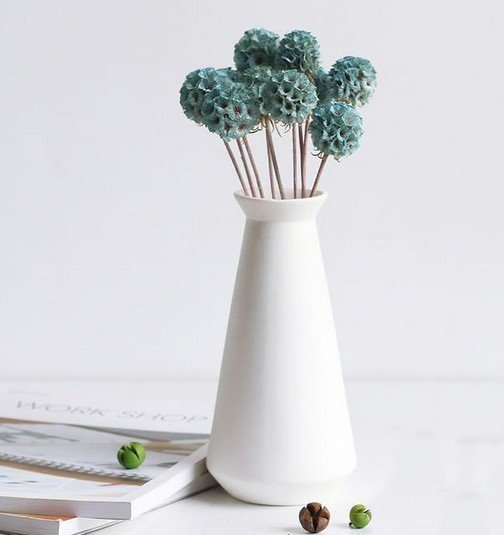Scabiosa flower specifications
- Scientific name : Scabiosa Columbaria
- French name : Colombaire, Scabiose colombaire
- Italian name : Soffione
- English names : Scabious, Lilac flowered scabious, Small scabious
- German name : Taubens Grindkraut
- Family : Caprifoliaceae
- Genus : Scabiosa
- Native region : Europe and Asia
- Other names : Mamsia, Tusk, Mami Tha, Mami Tha Sahara
- Lifespan : one or more years
- Propagation : Seeds and division of the plant
Scabiosa is a perennial plant of the caprifoliaceae family, which is native to Europe and Asia. This plant was discovered in 1782 by an Austrian botanist in the Alps.
Scabiosa flower is from scabiosa genus and 25 species of annual and perennial herbaceous plants grow in this genus in Iran. This plant has beautiful blue flowers and has an ornamental aspect and is suitable for use as cut flowers and planting in a variety of pots, planting in gardens, pastures, meadows and rock gardens.
read more : Everything about teasels plant : How to Plant & care for them

scabiosa flower
Introducing scabiosa flowers
Scabiosa flower is a perennial plant with medium growth rate that takes between 2 to 5 years to reach its final growth. The height of this plant is between 50 cm to 1 meter and its width is between 10 to 50 cm. This plant has a long stem, the leaves are long and narrow, opposite and without teeth and have a length of 5 to 15 cm.
The flowers of this plant appear on the stem of the plant in summer to autumn, have a diameter of about 4 cm and are blue, purple, pink, amethyst and white. Scabiosa flowers have a sweet aroma. The flowers are small, bluish in color and complex in the form of a capitol, but after turning the flowers into fruit, it looks round and beautiful.
read more : Everything about opium poppy flower : How to Plant & care for them
The place where Scabiosa flowers grow
Scabiosa flowers often grow in dry swamps, sunny mountain slopes and rocky terrain in various parts of Europe. In Iran, in different areas of Alborz, Amarloo, the distance between Kabutrchak and Pakdeh is 1850 meters, Zangoleh Bridge, the heights between Damash and Kherpoo, at altitudes of 1400 meters.
Scabiosa Care
The family Caprifoliaceae contains the genus Scabiosa, as well as other ornamental flowers such as honeysuckle and weigela. Scabiosa flowers earned the nickname pincushion flower thanks to their prominent stamens that emerge from the compact, round blooms like pins in a pincushion. Scabiosa plants form a low mound of foliage, and healthy plants may produce 20 to 50 blooms, each held individually on thin stems.
All things considered, scabiosa plants are exceedingly easy to care for, as long as you provide them with enough light and well-draining soil. In ideal growing conditions, your scabiosa plants will act as short-lived hardy perennials in USDA hardiness zones five through nine—they’ll bloom from spring until frost, with the heaviest blooming period occurring in May.
Keep the flowers deadheaded for the best chance at repeat blooming. Deadheading is laborious on plants that have so many small flowers on individual stems, so you can shear the plant in midsummer when the blossom output is low to encourage a new flush of blooms in early fall.
-
Light
Plant your scabiosa in a spot that plenty of sunlight each day, at least six to eight hours’ worth. Typically, this means a location that boasts full sun, but some partial afternoon shade is fine too, especially if you’re growing the blooms in a particularly hot summer climate. They will not do well when planted in a shady spot, and you will notice a reduction in blooms and buds if the plant isn’t getting enough light.
read more : Everything about hemlock flower : How to Plant & care for them
-
Soil
Scabiosa plants like soil that is moist but well-draining. They can fool you by blooming happily in clay soil for one season, but wet soils during their dormancy will turn your carefree perennial into an annual. If your landscape has heavy or boggy soil, you’re better off growing your scabiosa in raised beds. Additionally, the blooms are not particular about their soil pH and can thrive in a mixture that is neutral or slightly alkaline.
-
Water
Provide your scabiosa flowers with at least an inch of water weekly when they’re young and establishing their root systems. After that, the plants can tolerate brief periods of drought. Keep in mind, the hotter your weather, the more water they will need, so their tolerance for drought goes way down in the heat of the summer.
-
Temperature and Humidity
Scabiosa blooms do best in the moderate temperatures that spring to early summer and early fall offer. They dislike being hot or humid but can handle the weather of peak summer better if in a spot that is partially shady. Ultimately, if planted in the proper USDA hardiness zones, your scabiosa should have no problem growing well.
Fertilizer
Pincushion flowers are light feeders and can do well without being treated with fertilizer. That said, if you want to give your plants an extra boost (and up your chances of bountiful blooms), you can feed your scabiosa bimonthly with a balanced flower fertilizer during their growing season.
read more : Everything about vaccaria flower : How to Plant & care for them
Scabiosa Varieties
There are several different varietals of scabiosa plants available, most of which differ in color, and some slightly in flower appearance. Some of the most popular varieties include:
- Black Knight : A varietal that features burgundy flowers with prominent white stamens
- Butterfly Blue : A popular wedding varietal, with flowers that are more lavender than true blue
- Fama White : A varietal that thrives in cooler weather and produces larger, white flowers
- Pink Mist : A feminine varietal with flowers that are pink and near-translucent
Iran dried Scabiosa flower
Scabiosa flower is one of Iran’s export goods and has provided a great opportunity for Iranian traders to bring a lot of currency to the country by exporting dried scabiosa flower. Both types of scabiosa plant products can be exported either as medicinal plants or as dried flowers because each has its own customer.
The export of dried scabiosa flower has provided a great opportunity for wholesalers and exporters of dried scabiosa flowers and other medicinal plants to make significant profits.
read more : Drying natural flowers | Introducing 8 wonderful ways to dry flowers

Dried scabiosa flower
Propagating Scabiosa
Scabiosa plants can be propagated via division every two to three years, depending on how large your parent plant is getting. Division is a great way to keep growth under control, tame unruly plants, and help with overcrowding.
To propagate scabiosa, divide the plant in early spring, separating out several of the stronger, healthier stems for propagation. Plant them in your desired location, in an environment that closely mirrors that from which they came. Water gently and frequently until the plant becomes established—you should see growth from strong divisions within the first year.
- Planting seeds : in the fall.
- Plant division : Spring or summer is suitable.
- Propagate : to be applied in summer.
Notice : This article translated by google form Persian language. If you have any question or need more information please contact us or add a comment at the bottom of this page.



0 Comments